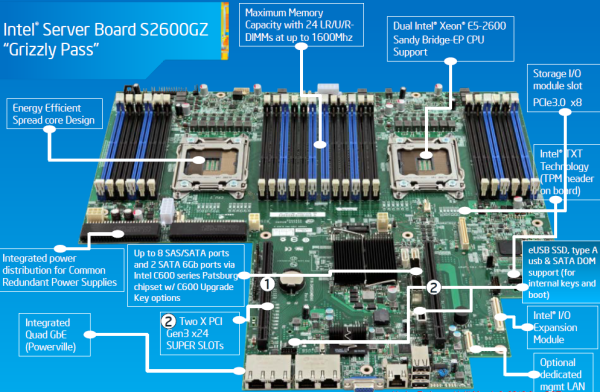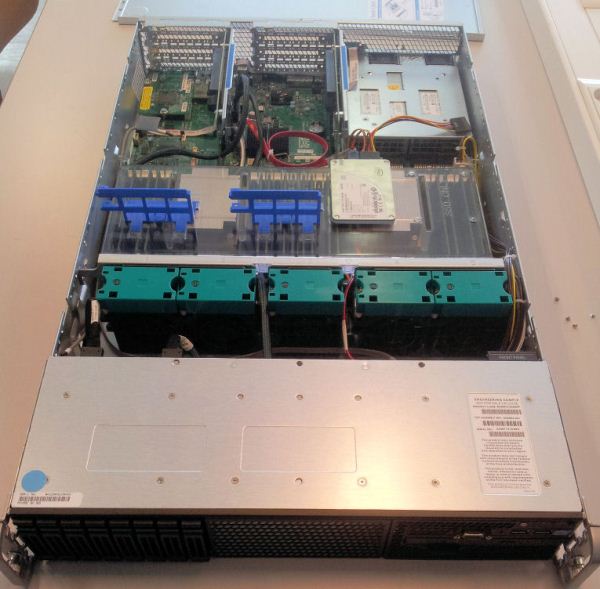The Xeon E5-2600: Dual Sandy Bridge for Servers
by Johan De Gelas on March 6, 2012 9:27 AM EST- Posted in
- IT Computing
- Virtualization
- Xeon
- Opteron
- Cloud Computing
The Intel S2600GZ board
Our Intel R2208GZ4GSSPP had the Intel S2600GZ "Grizzly Pass" board inside. The board has been qualified for all major virtualization solutions: Citrix Xenserver, Hyper-V, SLES 11, Oracle's VM server, RHEL and VMware vSphere of course. It can also be used as basis for almost every independent storage software vendor: DataCore, Falconstore, Gluster, Microsoft's iSCSI target, Nexenta, Open-E and Stormagic.
The board has a cooling and power-friendly spread core design: the airflow of one heatsink does not get used to cool another heatsink. The board features up to 24 DIMMs, which support Low Power, Unregistered and Registered DDR3 (up to 1600 MHz) and LR-DIMMs. Four GBe interfaces are on board and an optional I/O module can add dual 10 GBe (Base-T or optical) or QDR infiniband. Meanwhile the C600 chipset offers 8 SAS/SATA ports (2x 6G) and a PCIe 3.0 x8 module slot for stroage purposes. This slot can be used for setups such as the LSI 2208 dual core ROC controller based RAID card with two 8087 SAS connectors and 1 GB of 1033 MHz DDR3 cache.
Last but not least: the board has two PCIe x24 "super slots" which allows for the use of two risers. Each riser contains 3 PCIe 3.0 x8 slots: two half height slots and a full height slot. Finally, powering the system is a small 750 Watt PSU rated for 80 PLUS Platinum.












81 Comments
View All Comments
alpha754293 - Tuesday, March 6, 2012 - link
Thanks for running those.Are those results with HTT or without?
If you can write a little more about the run settings that you used (with/without HTT, number of processes), that would be great.
Very interesting results thought.
It would have been interesting to see what the power consumption and total energy consumption numbers would be for these runs (to see if having the faster processor would really be that beneficial).
Thanks!
alpha754293 - Tuesday, March 6, 2012 - link
I should work with you more to get you running some Fluent benchmarks as well.But, yes, HPC simulations DO take a VERY long time. And we beat the crap out of our systems on a regular basis.
jhh - Tuesday, March 6, 2012 - link
This is the most interesting part to me, as someone interested in high network I/O. With the packets going directly into cache, as long as they get processed before they get pushed out by subsequent packets, the packet processing code doesn't have to stall waiting for the packet to be pulled from RAM into cache. Potentially, the packet never needs to be written to RAM at all, avoiding using that memory capacity. In the other direction, web servers and the like can produce their output without ever putting the results into RAM.meloz - Tuesday, March 6, 2012 - link
I wonder if this Data Direct I/O Technology has any relevance to audio engineering? I know that latency is a big deal for those guys. In past I have read some discussion on latency at gearslutz, but the exact science is beyond me.Perhaps future versions of protools and other professional DAWs will make use of Data Direct I/O Technology.
Samus - Tuesday, March 6, 2012 - link
wow. 20MB of on-die cache. thats ridiculous.PwnBroker2 - Tuesday, March 6, 2012 - link
dont know about the others but not ATT. still using AMD even on the new workstation upgrades but then again IBM does our IT support, so who knows for the future.the new xeon's processors are beasts anyways, just wondering what the server price point will be.
tipoo - Tuesday, March 6, 2012 - link
"AMD's engineers probably the dumbest engineers in the world because any data in AMD processor is not processed but only transferred to the chipset."...What?
tipoo - Tuesday, March 6, 2012 - link
Think you've repeated that enough for one article?tipoo - Wednesday, March 7, 2012 - link
Like the Ivy bridge comments, just for future readers note that this was a reply to a deleted troll and no longer applies.IntelUser2000 - Tuesday, March 6, 2012 - link
Johan, you got the percentage numbers for LS-Dyna wrong.You said for the first one: the Xeon E5-2660 offers 20% better performance, the 2690 is 31% faster. It is interesting to note that LS-Dyna does not scale well with clockspeed: the 32% higher clockspeed of the Xeon E5-2690 results in only a 14% speed increase.
E5-2690 vs Opteron 6276: +46%(621/426)
E5-2660 vs Opteron 6276: +26%(621/492)
E5-2690 vs E5-2660: +15%(492/426)
In the conclusion you said the E5 2660 is "56% faster than X5650, 21% faster than 6276, and 6C is 8% faster than 6276"
Actually...
LS Dyna Neon-
E5-2660 vs X5650: +77%(872/492)
E5-2660 vs 6276: +26%(621/492)
E5-2660 6C vs 6276: +9%(621/570)
LS Dyna TVC-
E5-2660 vs X5650: +78%(10833/6072)
E5-2660 vs 6276: +35%(8181/6072)
E5-2660 6C vs 6276: +13%(8181/7228)
It's funny how you got the % numbers for your conclusions. It's merely the ratio of lower number vs higher number multiplied by 100.